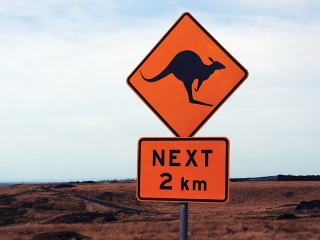Driving 'down under'

Australia’s historical ties with the UK show in that Australians drive on the left. Similarly all road signs are in English. Main routes are wide and largely of very good quality. All distances are measured in kilometres, which should be easier for Continental Europeans.
Overseas visitors to Australia can drive using their home country driving licences for up to three months, but there are restrictions and you should consult the rules of each Australian state to ensure that you comply.
Generally you can drive on a current overseas licence as long as: You are still a visitor, you have not been disqualified from driving, your licence has not been suspended or cancelled or your visiting driver privileges have been withdrawn. Tourists, people on limited-duration business visits and working visa holders are all regarded as temporary visitors. Some Australian states specify that licences must be written in English, or if not that the driver has obtained an international driving permit (IDP). Drivers must carry their current overseas licence, IDP or translation with them when driving.
Some car rental operators require a licence that includes photo ID. If your licence does not include this, you will need to obtain an IDP before travelling to Australia, if you want to rent a car.
Many road traffic laws are common across state borders. The blood alcohol limit is 0.05% throughout Australia and the police are very vigilant about this and on wearing seat belts.
Any accident involving injury must be reported to the police, and any driver involved in an accident must give assistance to any injured party if they are able to. Leaving the scene of an accident is regarded as a very serious offence and penalties are harsh.
A standard 50km/h speed limit applies in urban areas with streetlights. Signposted school zones have a 40km/h limit during certain school hours and are signposted in New South Wales and Victoria, often with flashing lights.
These limits also apply to days when teachers but not students are in school. Be aware that school holidays vary from state to state so crossing borders can suddenly mean you are in a school zone.
The speed limit outside the cities also varies between states. In Victoria, Tasmania, New South Wales, Queensland and South Australia the default speed limit is 100km/h.
In Western Australia and the Northern Territory the default speed limit is 110km/h and in the Northern Territory it can be up to 130km/h on major highways.
In Australia’s major cities, where you are most likely to be driving, early morning and early evening commuter traffic can bring congestion so best avoid these hours if you can.
A peculiarity of Melbourne is the tram system. Normally cars drive over the tram tracks and there will be a dotted yellow lane marker left of the tracks meaning cars can drive in the tram lane. If there’s a solid yellow line next to the tram lane, cars must not drive there.
Tram passengers have right of way when crossing the road to or from a tram. Open tram doors count as a stop sign; some (but not all) actually have a sign that pops out. Never drive past a tram at a stop.
It is illegal to turn left on a red traffic signal unless signposted, and in some states it is illegal to do a U-turn at a traffic signal, unless otherwise signed. In Victoria and the Australian Capital Territory this move is allowed on a right arrow except where signposted. Pedestrians always have the right of way.








Leave a comment